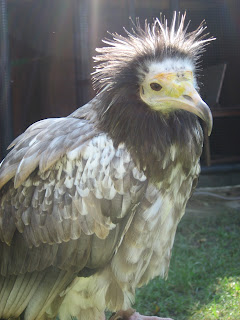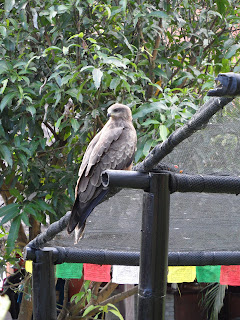Himalayan Raptor Rescue, where I am employed this year, is the first and only raptor rehabilitation facility in Nepal. Although cows and monkeys are considered sacred in the Hindu religion, birds are mainly overlooked.
 |
| With Bob, a juvenile Egyptian vulture |
 |
| Kevin, Egyptian vulture |
This is a small facility compared to other facilities I’ve worked at or visited. Based at Maya Devi in Pokhara, they receive around 5 to 10 birds a year. There are 5 resident birds here at the moment: two Egyptian vultures, Bob and Kevin, and three black kites, Brad, Sapana and Goggles. Both species are native to Nepal.
 |
| Bob, Egyptian vulture |
 |
| Kevin, Egyptian vulture |
Kevin and Bob, the two Egyptian vultures are great ambassadors for vultures as a group. Populations of many vulture species in Asia have been drastically declining over the past 20 years. The cause of the decline was just recently discovered in 2004. It’s due to an anti-inflammatory drug called diclofenac given to cattle. This drug is extremely toxic to vultures, so that if a vulture feeds on a cow carcass that had been injected with diclofenac during the last days of its life, it will inevitably experience liver and kidney failure and die. Of course, it’s never just one vulture feeding on a carcass, but it could be 150 vultures. The rate of decline has been astronomical. The Gyps vultures were once considered the most numerous raptors in the world, and today three species of Gyps vultures - white-backed vultures, long-billed vultures and slender-billed vultures – have lost 99% percent of their population and continue to lose 40% each year. Red-headed vultures and Egyptian vultures are also affected.
 |
| Critically endangered white-backed vulture |
There is a vulture-safe alternative to diclofenac, meloxicam. Since diclofenac was banned for veterinary use in 2006 in Nepal, India and Pakistan, it's use has declined somewhat. There is still a black market for diclofenac, and it is still being used. Fortunately, through education and diclofenac-meloxicam exchange programs there are more and more areas that can be declared diclofenac-free and vulture-safe. Within some of these areas, conservation groups are establishing vulture restaurants, where sick or old livestock is purchased, put to pasture and allowed to die a natural death. The carcass is then placed in a vulture feeding area as a safe food source for the vultures.
 |
| Scott at a vulture restaurant with Himalayan griffon vultures and some white-backed vultures |
Vultures the world over have bad reputations. They're scavengers, they're viewed as dirty, smelly, and ugly, but vultures have an extremely important role in the ecosystem. They are the cleaners, the purifiers. With the drastic decline in Asian vulture species, there has been an increase in the feral dog populations, and an increase rabies cases along with it. Hopefully, with removing diclofenac from the vultures' food sources, and captive breeding programs, the vultures of Asia will be able to make a comeback.
Himalayan Raptor Rescue raises awareness and raises funds for vulture conservation in Nepal. Last year, they were the single largest contributor, donating $10,000 to vulture conservation and helped to set up a vulture restaurant outside of Pokhara. For more information, visit www.vulturerescue.org.
 |
| Tango, black kite. Released in the spring and still hangs around |
 |
| Tango, black kite, in flight |


















